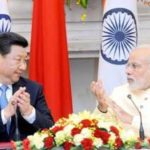Brief:
- India and China are the world’s two most populous countries and the fastest growing major economies. They also fought a short war in 1962.
- The Silk Road not only served as a major trade route between India and China, but is also credited for assisting the spread of Buddhism from India to East Asia.
- Chief issue in the past has been related with the border disputes, resulting in three military conflicts: Sino-Indian War (1962); Cho la Incident (1967) and Sino-Indian Skirmish (1987).
- Immense amount of distrust between both the countries because of China’s strong strategic bilateral relations with Pakistan.
- China didn’t support India’s pitch for permanent membership of the United Nations Security Council and is the only solitary of the P-5 members trying to hinder India’s bid.
- Although, both the countries are still trying to successfully rebuild a Sino-Indian tie which was stated as “partnership of the century”.
- Relations between these two Asian giants warmed up in the aftermath of the visit of the Chinese President Xi Jinping to India in September 2014 and the visit of the Indian Prime Minister Narendra Modi to China in May 2015 and September 2016
RECENT ISSUES:
- China blocking India’s bid to get a UN ban on Pakistan-based terrorist and JeM chief Masood Azhar as well as Beijing obstructing India’s entry in the Nuclear Suppliers Group.
- India and China conducted the first discussion on India’s NSG (Nuclear Suppliers Group) bid after China blocked India at the NSG plenary in Seoul.
- India would oppose the China–Pakistan economic corridor, which runs through POK.
- India is a member of MTCR (Missile Technology Control Regime), but China isn’t.
- China is a member of NSG (Nuclear Suppliers Group), but India isn’t.
- Both Countries want to be a part of what they don’t have.
- Foreign Secretary S.Jaishankar has termed relationship between India and China as ‘Complicated’ but not a Zero Sum Game.
- Meanwhile, China’s relations with its “all-weather friend” Pakistan are at an all-time high, with Beijing announcing that it will invest $46bn in the China-Pakistan Economic Corridor, which will connect Kashgar in China’s Xinjiang province with the port of Gwadar in Pakistan.
The POSITIVES
- Both countries met in the G20 summit held on 6th September 2016, and agreed to make efforts to put India-China ties in the “right direction” and to “respect and accommodate” each other’s concerns to avoid “impedance” relations
- After meeting Narendra Modi, Xi Jinping had said that “China is willing to work with India to maintain their hard-won sound relations and further advance cooperation”.
- India has been cooperating with China in many areas. It was one of the first countries to join the China-led Asian Infrastructure Investment Bank – which will offer the region a counterpoint to West-dominated financial institutions like the World Bank.
- The bilateral trade between India and China stood at US $70,71 billion in 2015-16. The total import and export volume of China, the world’s biggest trader, stood at 24.59 trillion Yuan in 2015.
- Beijing and New Delhi’s attempts to build a strategic and cooperative partnership while mounting trade and economic cooperation has resulted in China emerging as India’s biggest trading partner.
- However, a few wrinkles need to be ironed out on this front. India’s trade deficit with China has ratcheted up from 1 billion dollars in 2001-02 to 48.43 billion in 2014-15. This asymmetry has raised issues of sustainability.
- India and China are part of the G-20 Summit, the East-Asia Summit and BRICS, along with Brazil, Russia and South Africa. Furthermore, they have teamed up at global forums on climate change to resist demands commencing developed nations to agree to binding emission cuts.
- Although the two countries are considered political rivals, in October 2013, China and India inked the Border Defence Cooperation Agreement.
- The Agreement acknowledges “the need to continue to maintain peace, stability and tranquility along the line of actual control in the India-China border areas and to continue implementing confidence building measures in the military field along the line of actual control.”
- Delhi and Beijing are also keen to expand cooperation in such fields as railway and industrial park construction, security, anti-terror and anti-extremism, and to expand communication and exchanges in education and tourism, and facilitate more exchanges among regional governments of both countries
Given that India and China have many shared goals and areas of convergences, a bilateral relationship premised on a balanced economic engagement, along with some inventive and bold thinking on the political front, can benefit both nations while jump-starting an Asian revolution.











